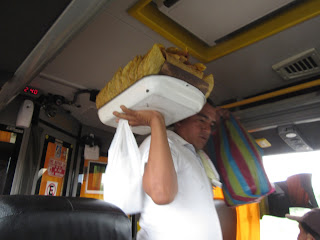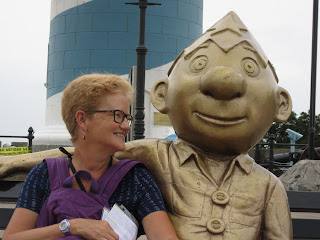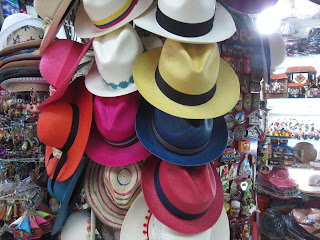We took a morning bus for the 3.5 hour drive through the spectacular
El Cajas National Park above the clouds to Guayaquil,
Ecuador’s largest city on the southern coast. Most travelers only see it as a
jumping off point for the Galapagos islands but we’d decided to stay three nights there
before leaving the mainland.
Steven and I were both relieved that we were in a nice warm bus this time and weren't hiking through the park as we did a few days ago!
I could only think what a hair-raising job the bus drivers have when driving the Cuenca-Guayaquil route with the narrow roads and the fog obliterating their sight of the road for long stretches. You couldn't pay me enough to drive that route more than once!
It felt like we were in a plane flying high above the clouds.
Once we neared the coast, vendors came on the bus plying their wares.
Our guesthouse owner’s son, Fabrizio, had lived in Toronto for a while and therefore was pretty
conversant in English. He offered to drive us to Las Penas, an historic, waterfront neighborhood at the base of
Santa Ana Hill for a small fee.
One of the most unusual monuments ever was this massive monkey in a major thoroughfare!
I had read that the colorful weathered houses and narrow, winding cobblestone streets made Las Penas one of the prettiest areas of the city. Though the houses were about a hundred years old, they mirrored those from three centuries ago, virtually all of which were destroyed in a fire in 1896 that wiped out about seventy percent of the city in just 36 hours.
Knowing we had 444 steps to climb before we could access
beautiful panoramic views at the top was daunting when we set out. But at least
we always knew how far we still had to go as the steps were numbered!
Not long ago, Guayaquil was considered loud, frenetic, dirty
and dangerous but since the city received a huge injection of cash for a slew
of urban regeneration schemes, the city’s image has undergone a radical
transformation among certain people. For many travelers, though, Guayaquil still had a horrific reputation for crime. No one we had met thus far on our travels had talked positively about the city and had chosen to stay longer than a night before escaping for greener pastures. Were we nervous and did we have second thoughts about the wisdom of our spending three nights and almost three full days in Guayaquil? Yes, absolutely but we felt we'd be OK if we took even more precautions than usual here in South America.
As we climbed, we passed literally dozens of heavily armed police so clearly there was still a crime problem in the area. But we felt safe as long as we didn’t walk into any of the adjacent alleys where muggings and worse had occurred.
The stairs weren’t steep and the steps seemed to pass by quickly.
Some of the homes had signs with photos of what the homes had looked like before they were painted bright colors. This house belonged (or had belonged) to the Montalban family.
More than halfway to the top was the Museo El Fortin de Santa Ana. There we saw cannons used to defend
the town from pirates and seafaring paraphernalia. Given pirates seemed to regularly raid Guayaquil, it
would seem the canons didn't work terribly well!
In the open-air museum was a reconstructed pirate ship half of which had been transformed into a bar.
Behind the museum was a large colorful billboard glamorizing the largely run-down homes of Las Penas.
I remember being struck the last time we saw a curvy highrise in Tirana, Albania last year. This one, on the west bank of the murky Rio Guayas, was similarly intriguing.
Finally, we made it to the top at step 444 and Plaza de Honores, a charming plaza with a lighthouse and a quaint chapel, the Iglesia de San Vicente, the oldest church in the city, founded in 1548.
We had hopes of climbing to the top of the lighthouse but they were dashed when we discovered it was closed for repairs.We learned later that this adorable figure was the 'face' of Guayaquil and copies were at most of the major sights and his image was on signs all over the city.
The priest rang the church bell repeatedly, indicating Mass
was about to begin.
and of the sprawling city, the largest in Ecuador.
The lighthouse, known as El Faro, symbolized New Guayaquil and, with its beacon, welcomed all to the city and signaled hope and progress in the nation.
Steven looked pretty happy at the prospect of walking down the steps, didn't he?!
Near the bottom step was an old mailbox which seemed a mighty strange place for one!
After walking down the steps, we spent some time in the
Museo Antropoloogico de Arte Contemporaneo, more commonly abbreviated to MAAC,
the centerpiece of a flagship arts complex located on the boardwalk of the Guayas River.
From the MACC's extensive grounds, we could see the lighthouse in the distance that we'd just walked down from.
It was hard to miss the body art promoting the Puyo area of
the Amazon in Ecuador. I was asked if I
wanted my body painted and I said no thanks especially after admiring that
young woman’s body.
On the museum's first floor were some photographs that reminded us of places we'd already seen in Ecuador and others we still planned to visit.
Coming up in a few days for us was a trip to the Galapagos.
The huge market in Otavalo:
Another adorable scene from the Galapagos:
Then we saw an art exhibition held in conjunction with the Spanish Embassy. This was the signature painting of the show.
Cocoa was called the fruit of the gods in Ecuador as the country's economy had once thrived on the cultivation of the cocoa bean.
I've always loved botanical prints; perhaps that's why I first began collecting Portmeirion china on a trip to England about 40 years ago.
If you read my first post about our visit to Cuenca and the hat factory, you will know what this means!
Another exhibit was titled 10,000 Years Through Old Guayaquil and focused on ceramic items from pre-colonial times. These were zoomorphic pots.
The selection of tiny figures was spectacular.
Jewelry made from shells:
Monkey figures from the Ecuadoran rainforest:
We had never been in a museum which was devoid of both museum goers and guards except for a staffer at the front desk. The lights went on in each room only as we entered one. What a shame more people hadn't also discovered the MACC as many of its displays were first-rate in our minds.
Outside, we saw more of the special exhibition promoting the Amazon.
Whoever thought of having a model painted with body art to promote the area was ingenious - what a stroke of smart marketing!
We began walking a few blocks to the Artisans Market. Fabrizio had told us it was safe to walk through it unlike the regular fruit and vegetable market which we normally would have also stopped at. On the way, we passed this sculpture. Only later did we realize and appreciate how many sculptures there were all over Guayaquil.
Just a few blocks from the market, we thought we’d been transported back to the US
seeing the KFC on the Run sign!
The hats were only $10! You may have forgotten that the US dollar is the currency used in Ecuador although coins were often different from the nickels, dimes, etc we use in the States.
It was hard to get away from hats in any market in Ecuador!
We spent some very enjoyable time picking out a painting very much in the Oswaldo Guayasamin style. He was the most famous Ecuadoran painter whose home and Chapel of Man we'd visited and thoroughly enjoyed in Quito.
A taxi took us to a mega mall just two blocks from our rundown guesthouse. It was there we grabbed some food in the food court and bought a few items in the grocery cum department store. The cineplex: How we've missed movies as we normally go most Fridays to the cheapie movie theater near our home to see a flick.
A wonderful array of fruits that were all new to us.
Alexander: I thought of you, hon, when we saw these chips!
Although we still had considerable trepidation about safety concerns for our next couple of days in Guayaquil, our first day was a very pleasant introduction to the city.
Next post: Guayaquil's White City - bet you can't guess what that is!
Posted on October 28th, 2017, from Cusco, Peru.





























































































444 steps!!! Oh my aching knees. Lil Red
ReplyDeleteUsing one's body as an artist's canvas -- a true human billboard ! xoxo
ReplyDeleteI love the art and statues. It is really cool what other cultures do in their city.
ReplyDeleteLina and Hadassah,
ReplyDeleteA human billboard - what a perfect description of the artist's canvas!
How lucky we were to combine a hike up 444 steps, body art, statues and a solitary journey through the museum.
Annie